St. Mang's Abbey, Füssen
St. Mang's Abbey, Füssen or Füssen Abbey (German: Kloster Sankt Mang Füssen) was a Benedictine monastery in Füssen in Bavaria, Germany. It was founded in the 9th century, and dissolved during the post-Napoleonic secularisation of Bavaria.
.jpg.webp)
History
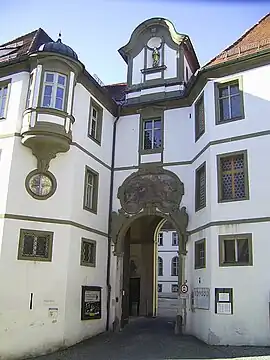
The Benedictine abbey of Saint Mang was founded in the first half of the 9th century as a proprietary monastery of the Prince-Bishops of Augsburg. The reason for its foundation goes back to the hermit Magnus of Füssen (otherwise known as Saint Mang) and his Benedictine brother Theodor, both from the Abbey of Saint Gall,[1] who built a cell and an oratory here, where he died on 6 September, although there is no record of which year.
The saint's body, amid miracles, was discovered uncorrupted, a proof of his sanctity, and the veneration of St. Mang was the spiritual basis of the monastery.
The foundation was not however solely spiritually motivated; there were practical political reasons underlying it as well. The monastery's key position not only on the important medieval road from Augsburg across the Alps to Upper Italy but also in the Füssen Gap ("Füssener Enge", the point where the river Lech breaks out of the Alps) gave it an immense strategic value, which made it of political concern both to the Bishops of Augsburg and to the Holy Roman Emperors.
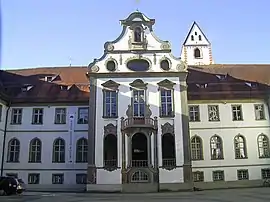
The history of the abbey in the Middle Ages is principally marked by the efforts of the religious community to maintain a life true to the Rule of Saint Benedict amidst the various pressures caused by external social developments. Over time therefore the monks repeatedly embraced various reforms and reforming movements intended to bring about a return to the essentials of the Benedictine life. These reforms mostly resulted in spiritual and economic growth and an increase in the headcount, which in turn brought more building and commissions of artwork.
The energy of the Counter-Reformation found lasting expression in the construction of an enormous Baroque abbey complex between 1696 and 1726, commissioned by Abbot Gerhard Oberleitner (1696-1714), which still today, along with the High Castle (Hohe Schloss), characterises the town of Füssen.
The architect Johann Jakob Herkomer (1652-1717) succeeded in turning the irregular medieval abbey premises into a symmetrically organised complex of buildings. The transformation of the medieval basilica into a Baroque church based on Venetian models was intended to be an architectural symbol of the veneration of Saint Magnus. The entire church represents an enormous reliquary. For the first time in South German Baroque construction the legend of the local saint inspires the suite of frescoes throughout the entire church. The community at the time also set out to make the new church the envy of connoisseurs for the quality of its artworks. Among the artists who contributed various forms of decoration for the building were Anton Sturm, Franz Georg Hermann,[2] Jakob Hiebeler and Paul Zeiller, whose only extant oil paintings are in the Chapter Hall.
Although the abbey was never able to obtain the coveted Reichsunmittelbarkeit (independence of all lordship except for that of the Emperor), it had a decisive influence as a centre of lordship and economy, cultural and faith life, on Füssen and the whole region.
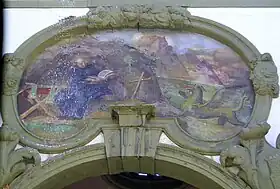
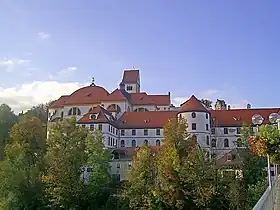
Dissolution
On 11 December 1802, during the secularisation that followed the Napoleonic Wars and the Peace of Lunéville, the princes of Oettingen-Wallerstein were awarded possession of St. Mang. On 15 January 1803 Princess Wilhelmine ordered Abbot Aemilian Hafner to dissolve the abbey and vacate the premises by 1 March of that year.
The contents of the library were shipped off to the new owners down the Lech on rafts. Most of the items are now in the library of the University of Augsburg, except for a small collection of especially valuable manuscripts, which are in the Augsburg Diocesan Archives.
Later history
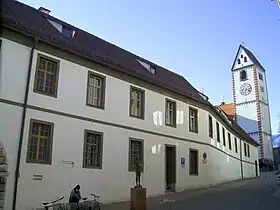
In 1837 the former abbey church was transferred as a gift to the parish of Füssen. In 1839 the Royal Bavarian chamberlain, Christoph Friedrich von Ponickau, bought the remaining lordship of St. Mang. In 1909 the town of Füssen acquired the Ponickau estate, including the former abbey buildings (apart from the church).
The north wing was used as the town hall. In the south wing the Füssen Town Museum is now located, with displays on the history of the abbey and of the town, particularly of the traditional manufacture of lutes and violins in Füssen.[3] It is also possible to view the Baroque reception rooms of the abbey in the museum.
List of the abbots of St. Mang's Abbey, Füssen
Until 919 there is no documentary evidence of the abbots of this abbey. Abbey tradition names Saint
Magnus as the founding abbot, and his successor as Blessed Conrad.
_Tour015_edited.JPG.webp)
_Tour014_edited.JPG.webp)


| Abbot | Period of authority | Date of death |
|---|---|---|
| 1. Saint Magnus | 6 September | |
| 2. Konrad I | ||
| 3. Wolpoto | 9th century ? | 26 April |
| 4. Bernold | 9th century ? | |
| 5. Leutolph | 9th century ? | |
| 6. Gisilo | occurs 919 | |
| 7. Ortolf | 5 April | |
| 8. Heinrich I. | ||
| 9. Gotebold | ||
| 10. Berthold | 23 August | |
| 11. Adalbert | ||
| 12. Wilhelm | c. 1030–1040 | |
| 13. Eberhard | c. 1060–1061 | 11 May 1091 |
| 14. Swidker | ||
| 15. Adalhalm | 1086 | 25 August 1094 |
| 16. Alberich | 23 January | |
| 17. Konrad II | occurs 1160–c.1175 | |
| 18. Heinrich II | occurs 1178–1191 | 19 February |
| 19. Konrad III | occurs 1206, 1218 | 14 July, c. 1218 |
| 20. Dieto (Theodo) | occurs 1219, 1222 | March 1225 |
| 21. Rugger | occurs 1227 | |
| 22. Rudolf von Thalhofen | occurs 1235, 1251 | 22 May |
| 23. Albert | occurs 1255 | 13 March 1256 |
| 24. Hermann I | occurs 1257, 1262 | |
| 25. Hiltebold | occurs 1263, 1283 | 19 October 1284 |
| 26. Konrad IV | occurs 1284, 1285 | |
| 27. Hermann II | occurs 1287, 1295, 1311 | |
| 28. Goswin | occurs 1313, 1317 | 8 July, c. 1318 |
| 29. Heinrich III | occurs 1319, 1335 | December, c. 1336 |
| 30. Ulrich Denklinger | occurs 1336, 1339 | 18 January 1347 |
| 31. Johannes I Hochschlitz | c. 1347 | 11 August |
| 32. Luiprand | occurs 1374 | |
| 33. Friedrich | occurs 1390 | 28 April |
| 34. Johannes II Lauginger | occurs 1392, 1396 | 21 March 1403 |
| 35. Georg I Sandauer | 1397–1410 | 15 February 1410 |
| 36. Yban von Rotenstein | 1410–1426 | 19 May 1439 |
| 37. Johannes III Schmerlaib | 1426–1431 | 16 May 1431 |
| 38. Konrad V Klammer | 1431–1433 | 13 March 1433 |
| 39. Johannes IV Fischer | occurs 1436; res. 1458 | 30 March 1460 |
| 40. Johannes V Hess | 1458–1480 | 1481 |
| 41. Benedikt I Furtenbach | 1480–1524 | March 1531 |
| 42. Joh. Baptist VI Benzinger | 1524–1533 | 8 April 1537 |
| 43. Gregor Gerhoch | 1537–1554 | 4 October 1554 |
| 44. Sympert Lechler | 1554–1556 | 21 November 1560 |
| 45. Georg II Albrecht | 1556–1560 | 2 February 1560 |
| 46. Johannes VII Kessler | 1560–1567 | 8 June 1567 |
| 47. Hieronymus Alber | 1567–1573 | 17 August 1573 |
| 48. Matthias Schober | 1579–1604 | 15 August 1604 |
| 49. Heinrich IV Amman | 1604–1611 | 30 July 1615 |
| 50. Martin Stempfle | 1614–1661 | 26 February 1665 |
| 51. Benedikt II Bauer | 1661–1696 | 26 July 1696 |
| 52. Gerhard I Oberleitner | 1696–1714 | 20 March 1714 |
| 53. Dominikus Dierling | 1714–1738 | 4 September 1738 |
| 54. Benedikt III Pautner | 1738–1745 | 18 January 1745 |
| 55. Leopold Freiherr von Rost | 1745–1750 | 7 November 1750 |
| 56. Gallus Zeiler | 1750–1755 | 7 January 1755 |
| 57. Placidus Zerle | 1755–1763 | 24 June 1770 |
| 58. Gerhard II Ott | 1763–1778 | 1 March 1778 |
| 59. Aemilian Hafner | 1778–1803 | 19 May 1823 |
References
- Saint Gall (Princely Abbey) in German, French and Italian in the online Historical Dictionary of Switzerland.
- Gerhard Woeckel (1969), "Hermann, Franz Georg", Neue Deutsche Biographie (in German), vol. 8, Berlin: Duncker & Humblot, pp. 652–653; (full text online)
- Füssen Heritage Museum
Sources
- Lindner, Pirmin, 1913. Monasticon Episcopatus Augustani antiqui. Bregenz.
- Ettelt, Rudibert, 1971. Geschichte der Stadt Füssen. Füssen.
- Leistle, David. Die Aebte des St. Magnusstiftes in Füssen, in Studien und Mitteilungen zur Geschichte des Benediktinerordens und seiner Zweige, 1918-1920.
- Riedmiller, Thomas, 2003: Das ehemalige Benediktinerkloster Sankt Mang in Füssen in Klosterland Bayerisch Schwaben (ed. W. Schiedermair). Lindenberg. ISBN 3-89870-127-1
External links
- High Castle of Füssen
- (in German) Klöster in Bayern
- (in German) Historischer Verein Alt Füssen
- St Mang Basilica Füssen